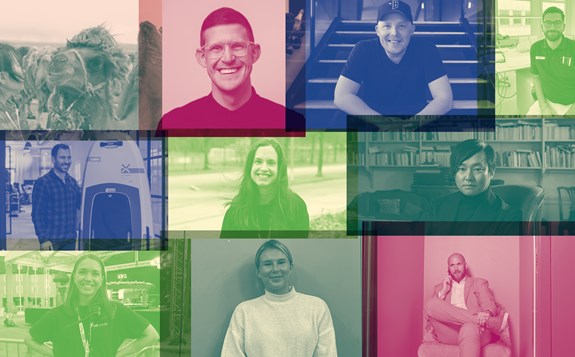Collaboration with students
Discover how we can make a difference together
Malmö University offers 130 programmes and 400 courses and there are opportunities to collaborate with our students in many different subjects and areas.
This is an opportunity to establish contact with committed students who are about to enter the working life and contribute to their knowledge development. The results of student collaboration are often put to practical use in your organisation. Perhaps it is your future colleagues you will be collaborating with.
Collaborators wanted for internships for K3 students
Internship for students studying culture, design, art and communications
What can you expect as a client?
As a client, you will benefit from the student's experience that they gain through their education. Not only do they bring a qualified background to the table, but also high ambition.
Students in all bachelor's programmes at the Department of Art, Culture and Communication (K3) are offered an internship course during the fifth or sixth semester. The course consists of 80% practice and 20% reflective self-study.
How does the collaboration work?
The arrangement for the internship is decided on between the supervisor at the workplace and the student. The internship can be about projects, assisting others in production or communication, etc.
- The agreement between the internship organisation and the student must be made no later than 1 June and the contract between Malmö University and the place of the internship is written at the beginning of June.
- For students in the Media and Communication Sciences programme, the internship is in the spring. The agreement between the internship organisation and the student must be made no later than 1 December and the contract between Malmö University and the place of the internship is sent out from 10 December.
What is required of you as a client?
Above all, the tasks must be relevant to the student's education, but at the same time not too complex and adapted for an intern. Supervision is expected. One component of the internship is a meeting with the student's supervisor from Malmö University where the student must present the workplace.
Questions and information
Please contact us if you have any questions.
Study Administrator: Malin Mc Glinn
Study and careers adviser: Viktoria Brännström
Information about education collaborations
You may gain new perspectives on challenges facing your organisation or a solution to a practical problem. This could involve students reviewing a product or service development process or proposing a technical solution. Collaboration can also create opportunities for future recruitment.
The most common types of student collaboration are degree projects, project assignments, internships and work placements.
A degree project
A degree project is often done as the final project in a programme and the results are usually presented in the form of a report. When a degree project is done in collaboration with an organisation or company, it often revolves around a question or a problem that the client wishes to investigate. In addition to proposing solutions to a specific problem, the student can contribute new ideas and perspectives that can be used in the organisation. Collaborating with a student can also mean you get to meet a potential future employee.
What is required of the client?
The client formulates a question or a problem that is then discussed and reformulated in consultation with the student and their supervisor. This is done to ensure that the student's work fulfils the academic requirements for a degree project.
The client must also appoint a contact person who, during the course of the work, has an ongoing dialogue with the student. The contact person answers the student's questions and gives feedback on the results. The student also has a supervisor at the University who follows up on and supports the work.
How long time does it take?
The length of degree projects varies, but usually covers 10 weeks of work.
What does it cost?
The degree project is part of the studies and there is no requirement for compensation. Any compensation, salary or fee is a matter between you and the student. It is not regulated by the University.
Project assignment
Collaborating on a project assignment gives your organisation the opportunity to get a solution to a practical problem or to have a question investigated. This could, for example, involve reviewing a product or service development process or drawing up proposals for a technical solution.
Unlike a degree project, a project assignment is a more confined, clearly defined project where the practical results are sometimes more important than the report itself. The project group may consist of one or more students.
What is required of the client?
Your organisation must identify a clearly defined project. The conditions may vary between programmes, but a common requirement is that the organisation must provide a supervisor who ensures that the students can get started with their work and receive the necessary guidance.
How long will it take?
The length of project assignments varies but is usually limited to a few weeks of work.
What does it cost?
Project assignments are part of the studies and there is no requirements for compensation. Any compensation, salary or fee is a matter between you and the student. It is not regulated by the University.
Internships and work based placements
By accepting an intern, you get to work with a student who is able to carry out qualified tasks that must be related to their education. This is a way to bring new ideas into the organisation and can be an opportunity for future recruitment.
What is required of the client?
At the organisation or company, the student must have a supervisor who ensures that the student can get started with their work and receives the necessary guidance. Depending on the programme, specific requirements may apply. The student also has a supervisor at the University who follows up on and supports the work.
How long will it take?
The length of the internship varies between different programmess but often involves 5–10 weeks of work.
What does it cost?
Internships are included in some programmes and there are no requirements for compensation. Any compensation, salary or fee is a matter between you and the student. It is not regulated by the University.
More about internships on the Student website
Work-based placements
Work-based placements (so-called VFU) occur mainly in teacher training programmes and in a number of different healthcare programmes. VFU is a mandatory part of the studies and collaboration is regulated by agreement.
Collaborative learning
The collaborative learning method (in Swedish called samverkansinlärning, short SI) is a complement to the regular teaching of a course, the idea being that the learning of a subject is enhanced by the exchange of thoughts and ideas between pupils and students. It is an approach to learning where intrinsic motivation and curiosity are the key drivers and where the emphasis is on self-driven and collective learning.
This method should not be a replacement for something else, but instead be a bonus. It is suitable for a course or subject that is perceived as difficult, with hurdles — a course that, for example, has a poor throughput.
Annette Zeidler, SI coordinator at Malmö University
How does collaborative learning work
This collaborative learning method normally takes place in meetings of about 5-15 pupils where the discussion is led by a student. The student should not be a teacher but rather clarify difficult issues in the subject by asking questions, acting as a sounding board, initiating work in small groups and coordinating the presentation of conclusions. The older student undergoes an initial SI leader training programme where they are given the necessary tools to use during their stay as SI leader.
Malmö University is one of several higher education institutions included in the national collaboration on this method and has been using it since the 2014 autumn term. The method was first used in maths and programming courses and worked well instantly. But the method works equally well in other subjects. Now we offer upper secondary schools to collaborate with us and our SI leaders.
Want to use the collaborative learning method at your school?
Through Malmö University, your school can get help from our student SI leaders. SI leaders can be used as an extra resource to the class teacher with difficult courses by holding group discussions. Our SI leaders follow a class for a whole term.
Contact
If you are interested in working together with Malmö University and use our SI-leaders as an extra resource you are welcome to contact our SE coordinator Annette Zeidler.
How it works
What is expected of me?
That depends on the nature of the assignment. In most cases, the students need a contact person at your organisation to guide them whilst they work on the assignment.
How long will it take?
The length varies, but usually, the collaboration is relatively short (between 2-10 weeks).
How much does it cost?
There is no requirement for compensation. Any compensation, salary or fee is a matter between you and the student and is not regulated by the University.
How is the final result presented?
The results are usually presented in a written report and orally at the University where you are usually invited to participate.
How is sensitive information handled?
If confidential information is involved, this can be resolved by the student writing two reports: a declassified academic essay and a report for you. If most of the results should not be made public, it is not appropriate for the assignment to be carried out as a student collaboration.
Who owns the right to use what the student develops?
Reasonable distribution of ownership and right of use depends on the conditions of the collaboration, such as whether or not the student receives compensation. Before the collaboration begins, the client and student can sign an agreement that regulates the rights to what the student develops. Regardless of ownership rights, it must be possible to use the end results in teaching and show them as work samples.
Other ways to collaborate
We are open to new ideas and welcome collaborations with our students' future employers. Get involved and contribute to the knowledge development of Malmö University's students.
Other ways to collaborate
Participate in career events
Participate in career events
We can help you organise career events that are aimed at all our students, doctoral students and alumni or a specific faculty, department or programme at Malmö University. Through these events, you can promote job vacancies, internships, trainee programmes and other collaboration opportunities. Contact our career service.
Recruit a student
Recruit a student
As an employer, you can advertise on Malmö University's job portal, Future Finder, to recruit students for: Internships, Degree work and Jobs. The service is offered free of charge and the adverts are aimed at current students and students entering the working world.
Collaborate with students on a complex challenge
Collaborate with students on a complex challenge
Become a partner and client for Malmö University's innovation competition Stormathon. The collaboration not only means an opportunity to have a challenge you are facing illuminated from new perspectives but is also an opportunity to come in contact with driven students and to actively participate and contribute to their knowledge development.



